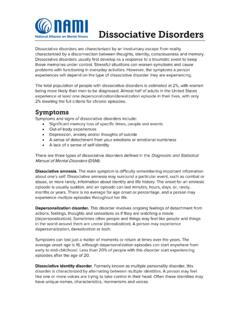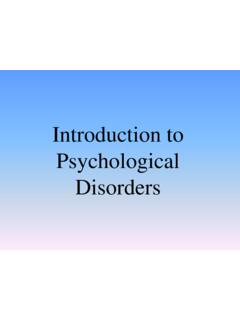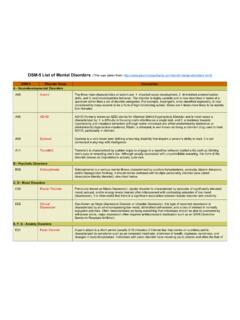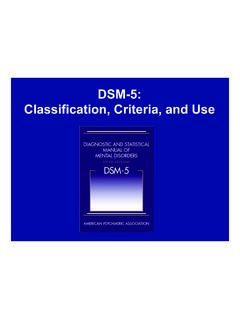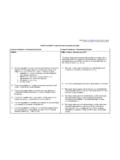Transcription of Psychopathology & Abnormal Psychology
1 Psychopathology & Abnormal Psychology We have talked about individual differences in personality, abilities, etc., but some individual differences go beyond the range of normal functioning and are usually called psychological disorders Just how to define Psychopathology is the subject of some disagreement Is it simply statistically infrequent behavior? Violation of social norms? Behavior that produces personal distress? Maladaptive or dysfunctional behavior? Psychological disorders generally fit several of these criteria Classification schemes Three categories (up until about 25 yrs ago).
2 Organic brain syndromes Neurosis: any disorder characterized by conflict and anxiety that cause distress and impair a person's functioning but don't render him/her incapable of coping with external reality ( , phobias, panic disorder, obsessive-compulsive disorder, etc.). Psychosis: any disorder characterized by severely disordered thought or perception to the point of a break with reality ( , schizophrenia, bipolar disorder). Examples Classification schemes The current emphasis is on clear, observable criteria (vs. theory-based inferences about unseen processes, , unconscious conflict ).
3 Terms have changed somewhat neurosis: not as widely used psychosis: still used but more narrowly DSM-IV. Classification and Diagnosis of Mental disorders Diagnostic and Statistical Manual IV. (DSM-IV): The most widely used scheme for classifying psychological disorders The Bible of mental disorders Catalogue of mental disorders and how to diagnose them Five Axes, or categories of evaluation Classification and Diagnosis of Mental disorders DSM-IV axes (the individual gets an evaluation on each axis). Axis 1: Major Clinical Syndromes Axis 2: Personality disorders Axis 3: Physical disorders Axis 4: Stressful Life Events Axis 5: Overall Level of Functioning Anxiety disorders Anxiety disorders are characterized by anxiety.
4 A sense of apprehension or doom that is accompanied by many physiological reactions, such as accelerated heart rate, sweaty palms, tightness in the stomach, tension, fear, insomnia Generalized anxiety disorder Phobias Panic disorder (PD). Obsessive-compulsive disorder (OCD). Stress disorders Generalized Anxiety Disorder Anxiety is free-floating, not related to any clear object Person is visibly worried and fretful, oversensitive, can't concentrate or make decisions, suffers from insomnia Physiological accompaniments: rapid heart rate, irregular breathing, excessive sweating, chronic diarrhea Specific Phobias Irrational, persistent fears, anxiety, and avoidance that focus on specific objects, activities, or situations People with phobias realize that their fears are unreasonable and excessive.
5 But they cannot control them Specific Phobias Name Object or Situation Feared Acrophobia Heights Agoraphobia Open spaces Algophobia Pain Astraphobia Lightning and thunder Claustrophobia Enclosed spaces Hematophobia Blood Monophobia Being alone Mysophobia Dirt or germs Nyctophobia Darkness Ochlophobia Crowds Pathophobia Disease Pyrophobia Fire Taphophobia Being buried alive Triskaidekaphobia Thirteen Zoophobia Animals, or a specific animal Social Phobias Social phobias are very common and often involve, for example, Fear of embarrassment or humiliation in front of others Avoidance of situations of possible exposure to public scrutiny Avoidance of public speaking or performing for fear of failure Avoidance of restaurants for fear of choking on food Phobias Possible Causes Classical conditioning, , Fear of dogs after a dog bite Fear of heights after a fall Oversensitivity to some stimuli Unrealistic beliefs Evolutionary.
6 Phobias are excessive manifestations of otherwise useful fears, , fear of heights could have been naturally selected, because it was useful to our ancestors to avoid falling to death Panic disorders Panic Disorder (without Agoraphobia): Characterized by sudden attacks of acute anxiety and a feeling of terror, accompanied by high levels of physiological arousal. Lasts from a few seconds to a few hours Panic Attack: Feels like one is having a heart attack, going to die, or is going insane Symptoms include vertigo, chest pain, choking, fear of losing control Panic Disorder (with Agoraphobia): Panic attacks and sudden anxiety still occur, but with agoraphobia Agoraphobia Agoraphobia (with Panic Disorder).
7 Intense, irrational fear that a panic attack will occur in a public place or in an unfamiliar situation Intense fear of leaving the house or entering unfamiliar situations Can be very crippling Literally means fear of open places or market (agora). Agoraphobia (without Panic Disorder): Fear that something extremely embarrassing will happen away from home or in an unfamiliar situation Obsessive-Compulsive Disorder (OCD). Extreme preoccupation with certain thoughts and compulsive performance of certain behaviors Obsession: Recurring images or thoughts that a person cannot prevent Cause anxiety and extreme discomfort Enter into consciousness against the person's will Most common: Being dirty, wondering if you performed an action (turned off the stove), or violence (hit by a car).
8 Compulsion: Irrational acts that person feels compelled to repeat against his/her will Washing hands, counting, checking, cleaning Help to control anxiety created by obsessions Treatment typically involves certain antidepressants and cognitive behavioral therapy including exposure- response-prevention'. Seems to have a genetic component Stress disorders Occur when stresses outside range of normal human experience cause major emotional disturbance Symptoms: Reliving traumatic event repeatedly, avoiding stimuli associated with the event, recurrent nightmares, flashbacks, and numbing of emotions Acute Stress Disorder: Psychological disturbance lasting up to one month following stresses from a traumatic event Post Traumatic Stress Disorder (PTSD): Lasts more than one month after the traumatic event has occurred.
9 May last for years Typically associated with combat and violent crimes (rape, assault, etc.). Terrorist attacks on September 11th, 2001, likely led to an increase of PTSD. Somatoform disorders Hypochondriasis: Person is preoccupied with having a serious illness or disease Interpret normal sensations and bodily signs as proof that they have a terrible disease No physical disorder can be found Conversion Disorder: Severe emotional conflicts are converted into impairment of sensory or motor function such as paralysis, anesthesia, blindness, deafness, etc. Caused by anxiety or emotional distress but not by physical causes, , glove anesthesia Examples: Soldier with battle fatigue becomes paralyzed; child who hates school is sick in the morning before the school bus comes Often considered a defense or way of escaping an intolerable situation Glove anesthesia is a conversion reaction involving loss of feeling in areas of the hand that would be covered by a glove (a).
10 If the anesthesia were physically caused, it would follow the pattern shown in (b). (right) To test for organic paralysis of the arm, an examiner can suddenly extend the arm, stretching the muscles. A conversion reaction is indicated if the arm pulls back involuntarily. (Adapted from Weintraub, 1983.). Return dissociative disorders A class of rare disorders in which trauma-related anxiety is reduced by a sudden disruption in consciousness, which then affects memory and identity a whole set of events (acts, thoughts, feelings, memories) are dissociated' or shoved out of ordinary consciousness dissociative Amnesia: sudden inability to remember important personal events or identity-related information that's too extensive to be due to normal forgetting, , inability to recall one's name, address, or past dissociative Fugue.
